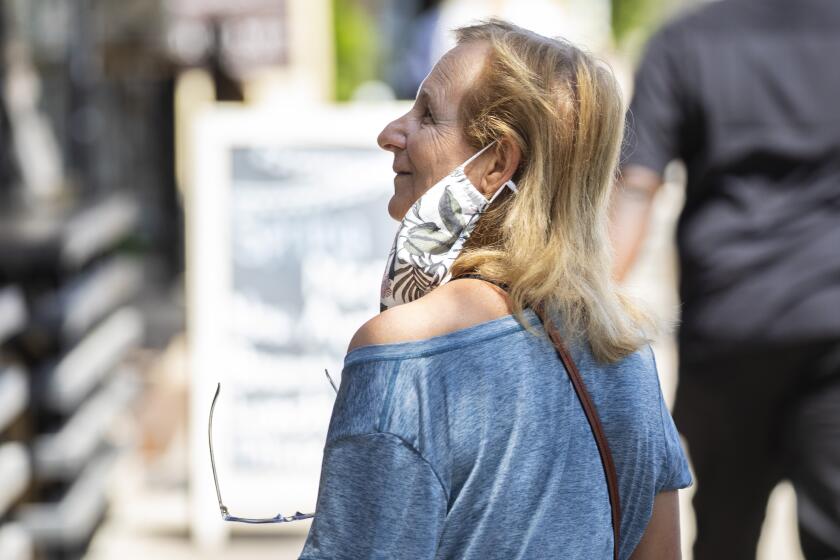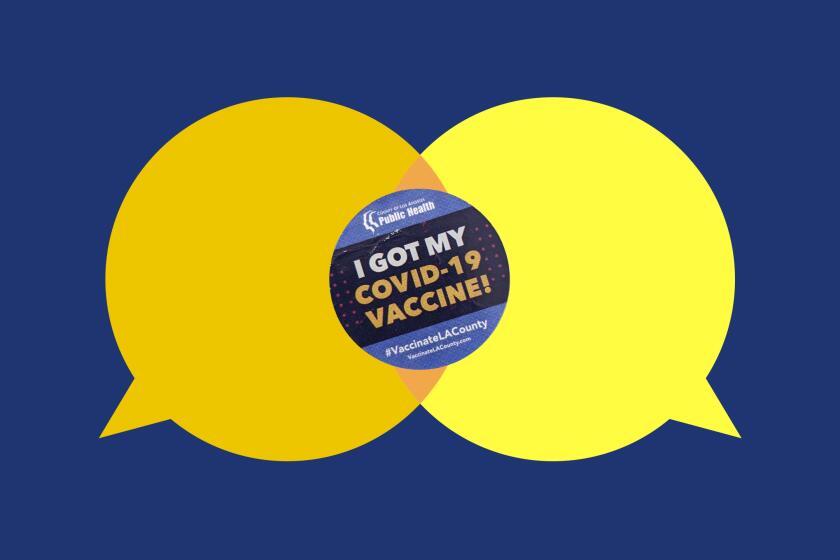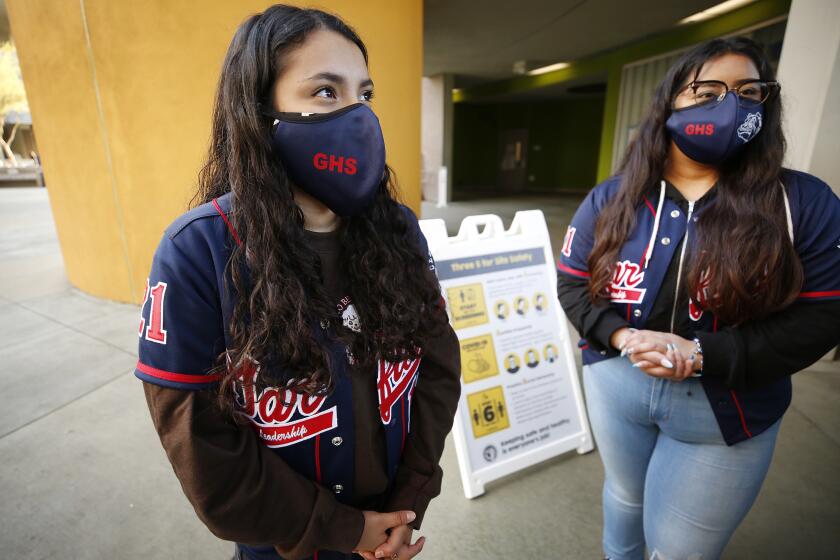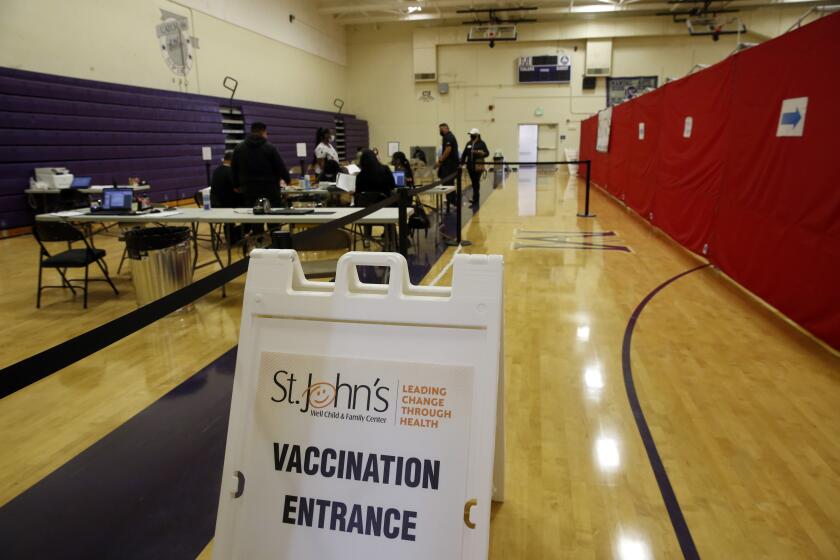Half of L.A. County residents 16 and older now fully vaccinated for COVID-19
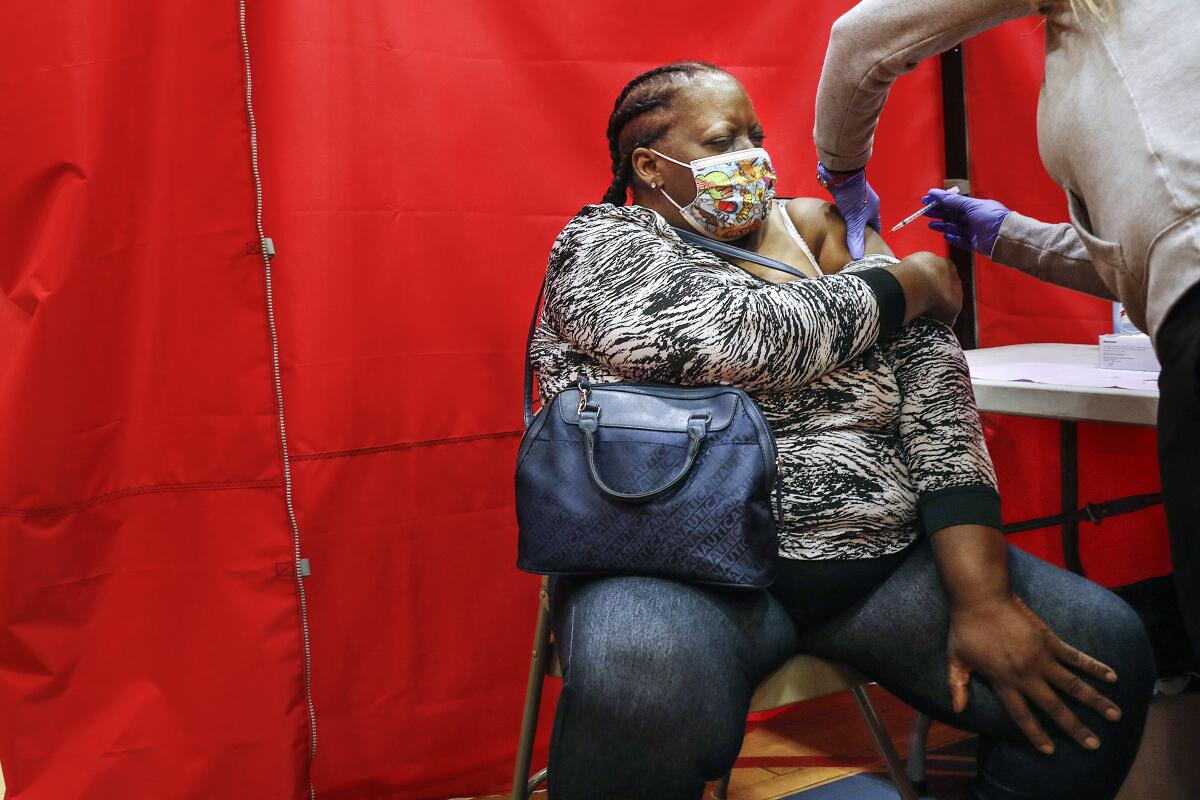
- Share via
Half of Los Angeles County residents 16 and older are now fully vaccinated against COVID-19, an encouraging milestone as the region — along with the rest of California — prepares to fully reopen in a few weeks.
“It is truly thrilling to see us reach this landmark, and I want to thank everyone who’s done their part to get us to this point,” county Public Health Director Barbara Ferrer said Monday.
But in a county the size of Los Angeles, that leaves millions more people who have yet to reach that level of protection — a gap health officials are racing to close before June 15, when the state will lift coronavirus-related limitations on business capacity, as well as physical distancing requirements for attendees, customers and guests at almost all businesses and other institutions.
“At long last, we’re putting the pandemic behind us,” L.A. County Supervisor Hilda Solis said. “This is only made possible due to our residents’ hard work to bring down cases and hospitalizations. And it’s also due to the willingness of residents across the county to get vaccinated as quickly as possible.”
From mask rules to social distancing, here’s what to expect come June 15.
Despite the county’s overall progress, there’s still plenty of room for improvement among younger Angelenos.
As of Friday, 46% of county residents 16 to 64 had been fully vaccinated, including only 28% of those who are either 16 or 17, according to figures Ferrer presented.
On the other hand, the county has made tremendous strides in inoculating seniors.
So far, 72% of residents who are at least 65 years old have been fully vaccinated countywide. An even higher share — 85% — have received at least one dose.
“The levels of vaccine uptake in seniors is what we’re really striving for in these other adults,” Ferrer said.
You want them to get vaccinated. They don’t. Now what? Tips from experts to have a conversation that could possibly change their mind.
There are several practical factors that have contributed to the age gap. For starters, seniors were prioritized far earlier in the vaccine rollout, as those in that age range are particularly at risk of falling seriously ill or dying from COVID-19.
The state didn’t open eligibility to everyone 50 and older until April 1 before expanding access to everyone 16 and up two weeks later.
Additionally, two of the vaccines currently available in the United States — the single-shot offering from Johnson & Johnson and Moderna’s two-dose regimen — are eligible only for use in adults. The Pfizer-BioNTech vaccine, which also requires two shots, can be used in children as young as 12.
Just because COVID-19 is especially dangerous for older residents doesn’t mean those who are younger are immune to its ravages, though. From April 1 to May 15, those between the ages of 30 and 49 accounted for more COVID-19 hospitalizations in L.A. County than any other age group.
“Lower vaccination rates in younger age groups means that not only are people in those age groups more likely to transmit COVID, but they’re also most likely to suffer its severe consequences,” Ferrer said.
If LAUSD — and all other California districts — do not fully reopen, they would lose state funding under rules already set to take effect.
While reaching a widespread level of community immunity has always been the end goal of the vaccine rollout, Ferrer acknowledged that effort is especially important in light of the state’s imminent reopening.
“We’re so excited to see this county thriving again, but along with this excitement, we feel a sense of great urgency to ensure that when we do reopen, we are set up for success,” she said. “And this means vaccinating as many county residents as we can over the next few weeks.”
California’s previous attempts at reopening were thwarted by resulting spikes in coronavirus infections, hospitalizations and deaths. But with increasing evidence of the vaccines’ real-world effectiveness, there’s a good deal of optimism that this time will be different.
Early on, the demand for vaccine doses was far greater than the available supply. Now, that dynamic has flipped, and providers are turning to alternate approaches and even incentives to reach as many people as possible.
The average number of doses being administered statewide has dropped from a peak of about 400,000 per day to more in the neighborhood of 250,000, according to data compiled by The Times.
L.A. County, too, is continuing to see large decreases in how many people are getting their first vaccine dose, Ferrer said.
“It’s clear that we need more folks coming in for the first dose appointments in order to create the conditions that can sustain our full reopening,” she said.
About 35% of Latino and 36% of Black California residents are at least partially vaccinated, while 52% of white and 63% of Asian American residents are.
Despite the drop-off in vaccines, the present state of the pandemic in California is rosy.
Over the last week, the state has reported an average of 1,168 new coronavirus cases per day — down 33% from two weeks ago.
And California’s latest positivity rate, the proportion of conducted tests that confirm coronavirus infection, was a minuscule 0.8%, according to Gov. Gavin Newsom.
“We’re mindful we still have work to do but very proud of the work of 40 million Californians strong,” he said Monday.
The trends seen in here are also playing out promisingly nationwide.
More than 130 million Americans — about 39% of the country’s population — are now fully vaccinated, according to data from the Centers for Disease Control and Prevention.
As of Friday, the national weekly average of new cases had dropped to 24,961 per day, a 40% decrease from two weeks prior.
Over the last month, federal officials have also noted “a steady decline in the number of counties in the United States with a high risk of community transmission,” said Dr. Rochelle Walensky, the CDC director.
According to the CDC, coronavirus transmission is currently considered moderate or low across much of California, including the state’s entire southern third.
“These data are telling us a story: As more and more people roll up their sleeves and get vaccinated, the number of cases and the level of community risk is decreasing,” Walensky said.
More to Read
Sign up for Essential California
The most important California stories and recommendations in your inbox every morning.
You may occasionally receive promotional content from the Los Angeles Times.
